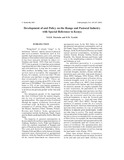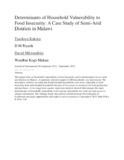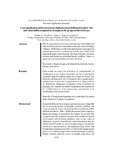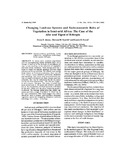Journal Articles: Recent submissions
Now showing items 1041-1060 of 1146
-
Dry matter yields and hydrological properties of three perennial grasses of a semi-arid environment in east Africa
(2010)Enteropogon macrostachyus (Bush rye), Cenchrus ciliaris L. (African foxtail grass) and Eragrostis superba Peyr (Maasai love grass) are important perennial rangeland grasses in Kenya. They provide an important source of ... -
Drought Management Strategies among Agro-Pastoral Communities in Non-Equilibrium Kalahari Ecosystems
(2011)Rural Kalahari communities whose livelihoods are heavily dependent on rain-fed agriculture are exposed to increasing intensity and frequency of drought spells. Subsequently their resilience is gradually being eroded and ... -
Different land use types in the semi-arid rangelands of Kenya influence soil properties
(2011)Rangelands in semi-arid Kenya have recently witnessed extensive land use changes. These changes can mainly be attributed to increased livestock populations and the response of the increased human population to both local ... -
Development of and Policy on the Range and Pastoral Industry with Special Reference to Kenya
(2003)Rangeland” or simply “range” is, by definition, “inferior” land by reason of physical and socio-economic limitations such as low rainfall, high temperatures, poor soils, and long distances from market outlets and supply ... -
Determinants of Household Vulnerability to Food Insecurity: A Case Study of Semi-Arid Districts in Malawi
(2013)This paper looks at household vulnerability to food insecurity and its determinants in two semiarid districts in Malawi. A randomly selected sample of 200 households was interviewed. The descriptive statistics revealed ... -
Desert Margins Program In Kenya: Integrated Socio-Economics Analysis Of Benchmark Sites
(2004)This paper presents socio-economic analysis of the Desert Margins Programme (DMP) benchmark sites in Kajiado and Makueni Districts in Southern rangelands, Marsabit District (Kalacha, Kargi, Korr and Ngurunit) and Turkana ... -
Constraints of rehabilitating degraded semi-arid lands of Kenya using indigenous perennial grasses
(2010)Land degradation which among others include loss of vegetation is rampant in Kenya, destroying both the fragile arid and semiarid lands and the non-arid areas. Efforts to rehabilitate semiarid areas by re-vegetation has ... -
Conceptualisation and measurement challenges in modelling pastorilists’ risk and vulnerability instigated by droughts in the group ranches of Kenya
(2014)This on-going study is assessing and modeling vulnerability and risks faced by pastoral communities in the dry areas of Lakipia in Kenya. Preliminary results from participatory rural appraisal indicate that poverty is ... -
Competition indices of three perennial grasses used to rehabilitate degraded semi-arid rangelands in Kenya
(2015)Rangeland degradation is one of the most serious environmental challenges in arid and semiarid environments in Africa. Grass reseeding technology, using indigenous perennial grass species has a great potential for restoring ... -
Common Range, Different Tribes: Explaining Resource Use, Management and Productivity among the Akamba, Orma and Somali in the former Eastern Statelands of Kenya
(2004)This paper describes the major livelihood activities of three ethnic communities who use in common the former Kenyan Eastern Statelands. It also looks at how the livelihoods and the range could be improved while maintaining ... -
Combining Sustainable Land Management Technologies to Combat Land Degradation and Improve Rural
(2015)Drylands occupy more than 80 % of Kenya’s total land mass and contribute immensely to the national economy and society through agriculture, livestock production, tourism, and wild product harvesting. Dryland ecosystems are ... -
Changing land use systems and socio-economic roles of vegetation in semi-arid Africa The case of the Afar and Tigrai of Ethiopia
(2000)In recent years, increased populations and the accompanying human demands have led to changes in land-use in the drylands of sub-Saharan Africa, in turn resulting in the reduction of vegetation and other natural resources. ... -
Assessing the potential of camel milk as a livelihood option in the face of climatic and environmental changes in drylands of Kenya
(2012)In drylands of Kenya, the adverse effects of climate variability and change has directly weakened the pastoral production system and made it less effective as a livelihood option. This has med most pastoral household food ... -
Synthesis, Antiplasmodial Activity, and β‑Hematin Inhibition of Hydroxypyridone−Chloroquine Hybrids
(American Chemical Society, 2013)A series of noncytotoxic 4-aminoquinoline-3-hydroxypyridin- 4-one hybrids were synthesized on the basis of a synergistic in vitro combination of a precursor N-alkyl-3-hydroxypyridin-4-one with chloroquine (CQ) and tested ... -
THE PEDAGOGICAL READINESS OF INSTRUCTORS TOWARDS ACHIEVING INTEGRATION OF ICTS IN TVET INSTITUTIONS IN KENYA
(2015)This paper points to the necessity to conduct research on the pedagogical readiness of instructors towards achieving integration of ICT’s in Technical and Vocational Education and Training (TVET) institutions in ... -
Kenya Towards Mobile Virtue Network Operator: Opportunities and Challenges
(Management Science and Information Technology, 2016)This paper points to the necessity to conduct research on Kenya towards Mobile Virtue Network Operator in regard to Opportunities and challenges. The telecommunication and financial business model is shifting away from ... -
Instant messaging an effective way of communication in workplace
(2013)The modern workplace is inherently collaborative, and this collaboration relies on effective communication among co-workers. Instant messaging is the multi-tasking tools of choice most people chatting over IM do other ... -
Features of Resource Based View Theory: An Effective Strategy in Outsourcing
(International Journal of Management and Commerce Innovations, 2016)In Resource Based viewpoint theory (RBV), the resources possessed by a firm are the primary determinants of its performance. The resources may remain latent until the firm deploy its capabilities, with these may contribute ... -
Curriculum Content Relevancy in Integration of ICTs in Kenya TVET Institutions in Readiness to Industry Needs
(International Journal of Secondary Education, 2017)The development of curricula content and their implementation is one of the key competences of instructors in the area of educational planning and practical training for Technical and Vocational Education and Training ...




















